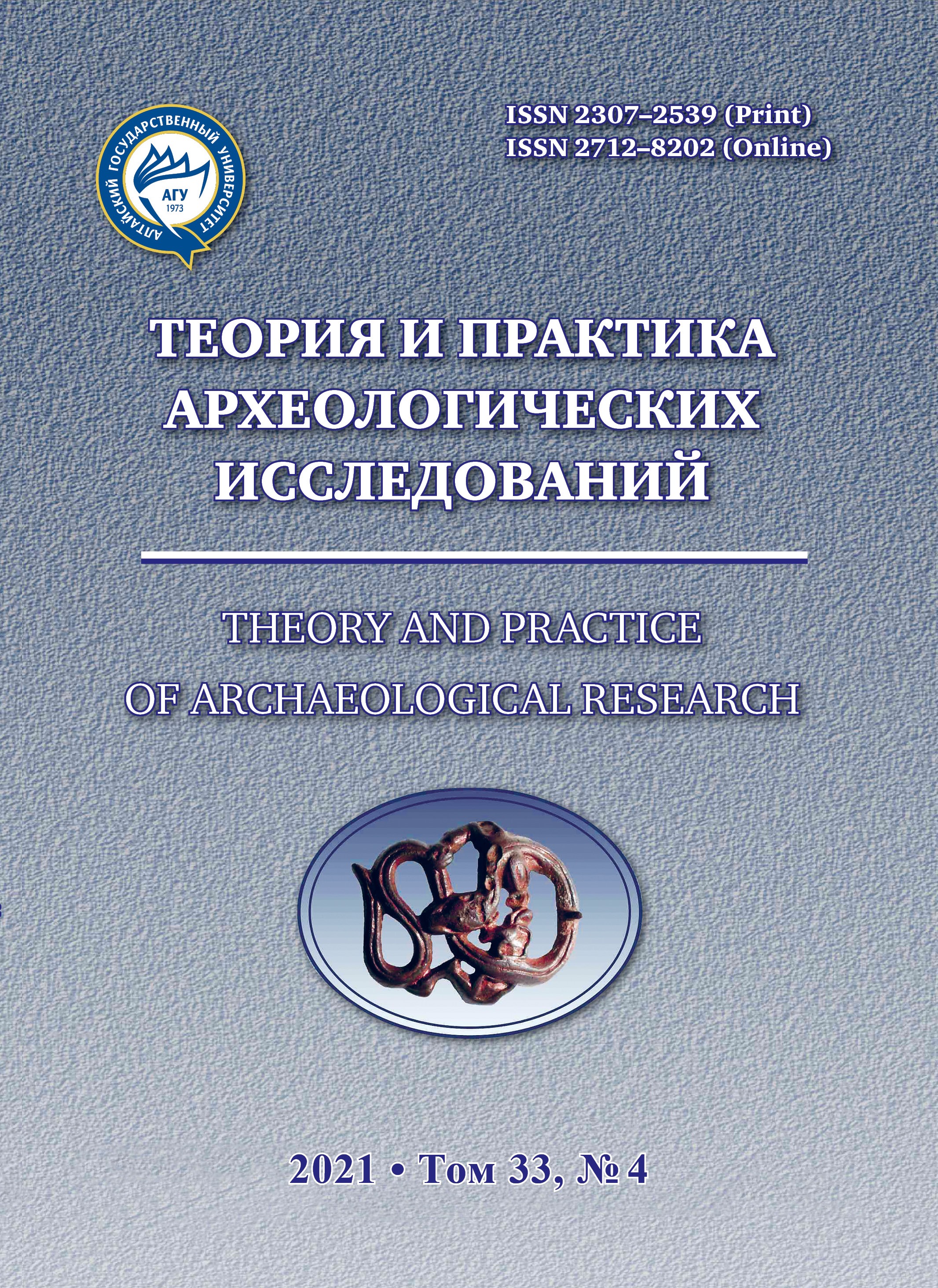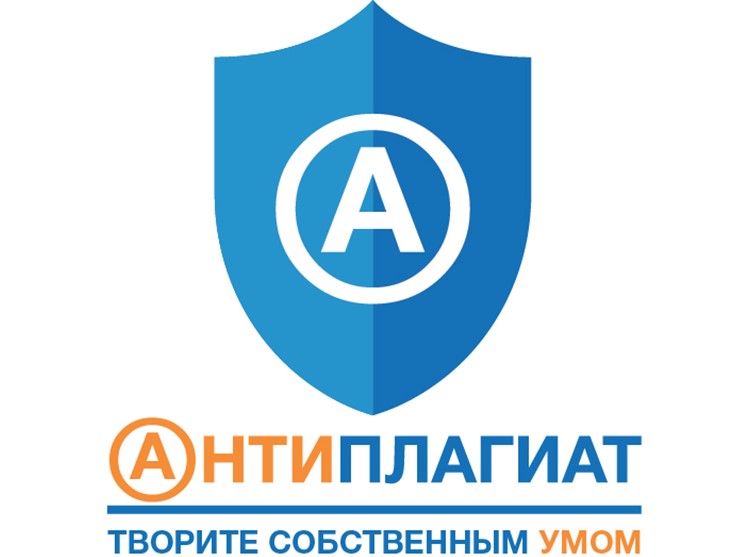Ancient Ritual Objects of the Oka Plateau (Eastern Sayan)
Abstract
Sacral beliefs took one of the most important spheres in the life of ancient societies. The evidence of such beliefs can be recognized in stone constructions used for various ritual activities and differentiated by architectonic features depending on their functionality. Some of such constructions were found on the territory of the Oka region (Buryat Republic). One part of them has a four-angled, circular, or ring-shaped form and a diameter up to 2 m; the other had circular burial mound-like or flat configuration with a diameter of 3–6 m. The first excavations of the large stone mounds of the circular form were carried out in 1870 P.A. Rovinskiy near the Oka guard fort (archeological site Oka, locality 1 and 2). The researcher characterized excavated constructions as cenotaphs or sacrificial places. In 2020 A.V. Kharinskiy excavated other two large stone mounds at the Shasnur-3 archeological site. Based on materials from excavations reinforced with ethnographical data, we can regard circular mounds with the 3–6 m diameter in the Mountain Oka region as cenotaphs. One of the small ring-shaped stone settings was investigated by V.I. Tashak at the Zun Nomto-Gol-1 archeological site. Taking into consideration the ethnographical data, the setting from Nomto-Gol-1 as other stone settings with a diameter up to 2 m can be characterized as ancient sacrificial places devoted to the spirits — hosts of the local landscapes. Key words: ancient ritual objects, burial grounds, Eastern Sayan, Oka plateau,
Downloads
Metrics
References
Antonova Yu.E., Miyagashev D.A. Shamhagbaisan as a sacral object of antiquity in the Oka river valley (western Buryatia). Vestnik Tomskogo gosudarstvennogo universiteta. Istoriya = Tomsk State University. Journal of History. 2013;3(23):103–107. (In Russ.)
Arzhannikov S.G., Ineshin E.M., Arzhannikova A.V., Snopkov S.V. Paleogeography conditions of human habitation in the valleys of the Oka Plateauin the Eastern Sayan Mountains (on the example of Sentsa River valley). Izvestiya Laboratorii drevnih tehnologij = Reports of the Laboratory of Ancient Technologies. 2010;8:291–302. (In Russ.)
Баярсайхан Ж., Түвшинжаргал Т., Тэйлор В., Батсайхан З., Лаури Б. Бор шорооны амны дурсгалт газарт хийсэн архиологийн судалгаа. НҮҮДЭЛЧДИЙН ӨВ СУДЛАЛ. Улаанбаатар, 2018. TOM-XIX-II, FASC 1-24. С. 5–28. (In Mongolian)
Dashibalov B.B. Archaeological sites of the Oka Region in Buriatia Republic. Ulan-Ude, 1994. Arhiv nauchno-proizvodstvennogo centra Ohrany pamyatnikov, inv. No. 64 = The Archive of the Research, Development and Production Centre of the Cultural Heritage Protection. Inventory N64. 67 p. (In Russ.)
Kropotkin P.A. The Travel to the Oka Guard Fort. Zapiski Sibirskogo otdela Imperatorskogo Russkogo geograficheskogo obshchestva. Knizhki IX i X = Notes of the Siberian Branch of the Imperial Russian Geographical Society. Books IX and X. Irkutsk : Tipografija Okruzhnogo shtaba, 1867.. Pp. 1–94. (In Russ.)
Miyagashev D.A. The Report of the Works on Distinguishing Boundaries of the Archaeological Sites in the Oka Region of the Buriatia Republic. Ulan-Ude, 2012. Arhiv nauchno-proizvodstvennogo centra Ohrany pamyatnikov, inv. №205 = The Archive of the Research, Development and Production Centre of the Cultural Heritage Protection. Inventory N205. 42 p. (In Russ.)
Obruchev C.V., Lur’e M.L. Kropotkin and Peretolchin Volcanoes in Eastern Sayan. Trudy laboratorii vulkanologii. Vyp. 8 = Proceedings of the Laboratory of the Volcanology. M. : Izdvo AN SSSR, 1954. Vol. 8. Pp. 210–225. (In Russ.)
Okladnikov A.P. Angara Petroglyphs. M.; L. : Nauka, 1966. 322 p. (In Russ.)
Rovinskij P.A. About the Travel to Tunka and Oka as Far as Oka Guard Fort. Zapiski Sibirskogo otdela Imperatorskogo Russkogo geograficheskogo obshchestva = Notes of the Siberian Branch of the Imperial Russian Geographical Society. Irkutsk : Izd-vo tipografii Sinicyna, 1871. Pp. 31–52. (In Russ.)
Savel’ev N.A. B.E. Petri’s Contribution to the Siberian Neolithic Investigations. Paleoetnologicheskie issledovaniya na yuge Srednej Sibiri = Paleoetnological Investigations in the South of the Middle Siberia. Irkutsk : Izd-vo Irkutskogo universiteta, 1991. 252 p. (In Russ.)
Tashak V.I. New Studies of the Rock Arts in the Oka Plateau. Vestnik BNC SO RAN = Bulletin of the BSC SB RAS. 2020;4(40):9–17. (In Russ.) DOI: 10.31554/2222-9175-2020-40-9-17
Tashak V.I., Antonova Yu.E., Kobylkin D.V. Natural Science Methods in the Solution to Questions of Chronology of Stone Constructions in Ancient Sanctuaries. Kochevye imperii Evrazii v svete arheologicheskih i mezhdisciplinarnyh issledovanij. Kn. 1 = Nomadic Empires of Eurasia in Archaeological and Interdisciplinary Studies. Book 1. Ulan-Ude : Izd-vo BNC CO RAN, 2019. Pp. 176–177. (In Russ.)
Kharinskii A.V., Ozheredov Yu.I., Erdenebaatar D. The Northern Coast of Lake Khubsugul in the Paleometallic Time. Ekologo-geograficheskie, arheologicheskie i socioetnograficheskie issledovaniya v YUzhnoj Sibiri i Zapadnoj Mongolii = Ecological-geographical,
Archaeological and Socio-Ethnographic Studies in Southern Siberia and Western Mongolia: Russian-Mongolian Collection of Scientific Works. Barnaul : Izd-vo Alt. un-ta, 2006. Pp. 115–125. (In Russ.)
Erdenebaatar D. A Brief Outline of Archaeological Research in Mongolia. Izvestiya Laboratorii drevnih tekhnologij = Reports of the Laboratory of Ancient Technologies. 2009;9:113–148. (In Russ.)
Broderick L.G., Houle J.L., Seitsonen O., Bayarsaikhan J. The Mystery of the Missing Caprines: Stone Circles at the Great Khirigsuur in the Khanuy Valley. Studia Archaeologica. 2014;XXXIV:164–174.
Bronk Ramsey C. Bayesian Analysis of Radiocarbon Dates. Radiocarbon. 2009;51(1):337–360.
Ėnkhtör A., Bemmann J., Brosseder U. The First Excavations of Bronze and Iron Age Siyts in the Middle Orkhon Valley, Central Mongolia: Results from Rescue Investigations in 2006 and 2007 . Asian Archaeology. Research Center for Chinese Frontier Archaeology (RCCFA) and Springer Nature Singapore Pte Ltd. 2018.
Frohlich B., Amgalantögs T., Littleton J., Hunt D., Hinton J., and Goler K. Bronze Age Burial Mounds in the Khövsgöl Aimag, Mongolia. Bemmann, J., Parzinger, H., Pohl, E., and Tseveendorzh, D. (eds.), Current Archaeological Research in Mongolia, Rheinische Friedrich-Wilhelms-Universität. Bonn, 2009. Pp. 99–115.
Jeong C., Wang K., Wilkin S., Taylor W.T.T., Miller B.K., Bemmann J.H., Stahl R., Chiovelli C., Knolle F., Ulziibayar S., Khatanbaatar D., Erdenebaatar D., Erdenebat U., Ochir A., Ankhsanaa G., Vanchigdash C., Ochir B., Munkhbayar C., Tumen D., Kovalev A., Kradin N., Bazarov B.A., Miyagashev D.A., Konovalov P.B., Zhambaltarova E., Miller A.V., Haak W., Schiffels S., Krause J., Boivin N., Erdene M., Hendy J., Warinner C. A Dynamic 6,000-Year Genetic History of Eurasia’s Eastern Steppe. Cell 183, 890–904, November 12, 2020. Reimer P., Austin W., Bard E., Bayliss A., Blackwell P., Bronk Ramsey C., Talamo S. The IntCal20 Northern Hemisphere Radiocarbon Age Calibration Curve (0–55 cal kBP). Radiocarbon. 2020;62(4):725–757. doi:10.1017/RDC.2020.41
Wright J. Prehistoric Mongolian Archaeology in the Early 21st Century: Developments in the Steppe and Beyond. Journal of Archaeological Research. 2021;Springer.
Theory and Practice of Archaeological Research is a golden publisher, as we allow self-archiving, but most importantly we are fully transparent about your rights.
Authors may present and discuss their findings ahead of publication: at biological or scientific conferences, on preprint servers, in public databases, and in blogs, wikis, tweets, and other informal communication channels.
Theory and Practice of Archaeological Research allows authors to deposit manuscripts (currently under review or those for intended submission to ABS) in non-commercial, pre-print servers such as ArXiv.
Authors who publish with this journal agree to the following terms:
- Authors retain copyright and grant the journal right of first publication with the work simultaneously licensed under a Creative Commons Attribution License (CC BY 4.0) that allows others to share the work with an acknowledgement of the work's authorship and initial publication in this journal.
- Authors are able to enter into separate, additional contractual arrangements for the non-exclusive distribution of the journal's published version of the work (e.g., post it to an institutional repository or publish it in a book), with an acknowledgement of its initial publication in this journal.
- Authors are permitted and encouraged to post their work online (e.g., in institutional repositories or on their website) prior to and during the submission process, as it can lead to productive exchanges, as well as earlier and greater citation of published work (See The Effect of Open Access).








2.jpg)




